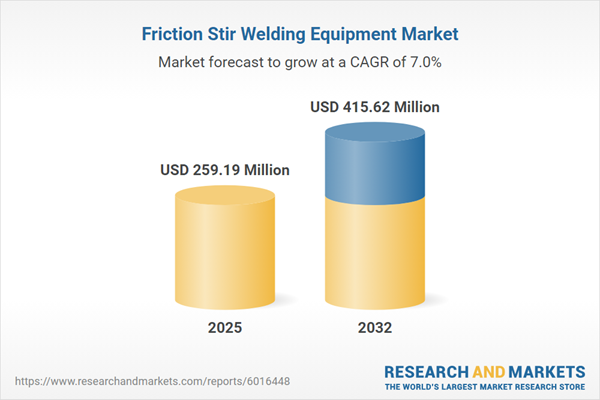Speak directly to the analyst to clarify any post sales queries you may have.
The friction stir welding equipment market is experiencing steady momentum as manufacturers pursue advanced joining technologies to meet rising standards for strength, efficiency, and sustainability in high-performance sectors.
Market Snapshot: Friction Stir Welding Equipment Market Growth
The friction stir welding equipment market grew from USD 241.89 million in 2024 to USD 259.19 million in 2025 and is projected to reach USD 415.62 million by 2032, expanding at a CAGR of 7%.
Scope & Segmentation
This report provides comprehensive coverage of the friction stir welding equipment sector, delving into market drivers, technology innovations, and the most relevant adoption trends by industry, material, application, and region. Segmentation includes:
- End-Use Industry: Aerospace and defense (commercial aviation, defense aircraft, spacecraft), automotive (EV, hybrid, ICE components), construction and infrastructure (bridges, tunnels, structures), electronics (component assembly, heat sinks), rail (freight, passenger, infrastructure), and shipbuilding/marine (cargo, naval vessels, offshore platforms).
- Material Types: Aluminum (cast, wrought, pure), copper (alloys, pure), magnesium (AZ31, AZ61), steel (carbon, HSLA, stainless), and titanium (grades 2, 5).
- Machine Types: Column boom, desktop, gantry, portable.
- Applications: Friction stir welding, friction stir spot welding, refill friction stir spot welding.
- Power Ratings: Above 10 kW, below 5 kW, between 5 and 10 kW.
- Cooling Systems: Air cooling, water cooling.
- Regions Covered: Americas (North and Latin America), Europe, Middle East & Africa, Asia-Pacific, with further analysis by key countries.
Key Takeaways: Friction Stir Welding Equipment Market
- Leading industries such as aerospace and electric vehicle manufacturing are prioritizing equipment that can deliver repeatable, high-integrity welds while accommodating advanced alloys.
- Advancements in digital twin integration, automation, and predictive maintenance are increasing operational uptime and supporting real-time process control.
- The dominance of aluminum alloys persists; however, there is rising traction for titanium and advanced steels driven by new structural demands.
- Increasing preference for portable and gantry machine designs addresses the need for flexibility across diverse production facilities and challenging geometries.
- Hybrid workstations combining additive manufacturing with friction stir welding are enabling rapid prototyping and efficient, low-volume production where structural reliability is non-negotiable.
- Regional adoption strategies reflect distinct industry ecosystems: established OEM clusters in the Americas, emerging energy and infrastructure projects in EMEA, and scale-driven investment in Asia-Pacific.
Tariff Impact and Supply Chain Adaptation
The implementation of United States tariffs on imported fabrication machinery in 2025 has significantly influenced sourcing decisions within the friction stir welding equipment supply chain. Leading providers are opting to expand local assembly operations and forge alliances with domestic fabricators to mitigate cost pressures and strengthen resilience. This shift drives increased scrutiny of component sourcing, favoring partners with regional capacity and supply diversification. As a result, industry competitiveness is evolving with more selective procurement and a greater emphasis on supply network flexibility to respond to policy volatility.
Methodology & Data Sources
The analysis is grounded in a multi-stage methodology, beginning with an extensive secondary research review of industry reports, patents, regulatory documents, and proprietary databases. This foundation was enhanced with primary research, including qualitative interviews and surveys targeting engineering leaders and procurement specialists across all end-use sectors. Findings were validated via peer review with subject matter experts to ensure accuracy and actionable insight.
Why This Report Matters
- Equips senior decision-makers with an actionable evaluation of technology, supply chain strategies, and competitive positioning to inform capital planning.
- Provides clarity on the evolution of end-use segmentation and regional demand, supporting targeted investment and partnership strategies.
- Highlights essential developments in automation and hybrid manufacturing critical for driving quality improvements and sustainable growth.
Conclusion
The friction stir welding equipment market stands at a pivotal point as innovation, supply chain resilience, and strategic localization become essential for sustained growth. This report delivers the necessary insights for leaders seeking to align with future market trajectories and capture emerging opportunities.
Additional Product Information:
- Purchase of this report includes 1 year online access with quarterly updates.
- This report can be updated on request. Please contact our Customer Experience team using the Ask a Question widget on our website.
Table of Contents
3. Executive Summary
4. Market Overview
7. Cumulative Impact of Artificial Intelligence 2025
Companies Mentioned
The companies profiled in this Friction Stir Welding Equipment market report include:- TWI Ltd
- ESAB AB
- Fronius International GmbH
- EWM AG
- Harms & Wende GmbH
- AFW Technologies, Inc.
- Beijing Reliability Technology Co., Ltd.
- Pro-Beam GmbH
- Somas GmbH & Co. KG
- Xi’an General Machinery Co., Ltd.
Table Information
| Report Attribute | Details |
|---|---|
| No. of Pages | 192 |
| Published | October 2025 |
| Forecast Period | 2025 - 2032 |
| Estimated Market Value ( USD | $ 259.19 Million |
| Forecasted Market Value ( USD | $ 415.62 Million |
| Compound Annual Growth Rate | 7.0% |
| Regions Covered | Global |
| No. of Companies Mentioned | 11 |









